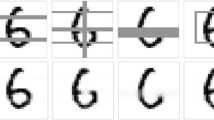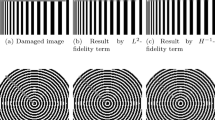Abstract
Image inpainting is the process of touching up damaged or unwanted portions of a picture and is an important task in image processing. For this purpose Bornemann and März (J Math Imaging Vision, 28:259–278, 2007) introduced a very efficient method, called image inpainting based on coherence transport, that fills the missing region by advecting the image information along integral curves of a coherence vector field from the boundary toward the interior of the hole. The mathematical model behind this method is a first-order functional advection partial differential equation posed on a compact domain with all inflow boundaries. We show that this problem is well posed under certain conditions.



Similar content being viewed by others
References
Aach, T., Mota, C., Stuke, I., Mühlich, M., Barth, E.: Analysis of superimposed oriented patterns. IEEE Trans. Image Proccess. 15(12), 3690–3700 (2006)
Aliprantis, C., Border, K.: Infinite Dimensional Analysis: A Hitchhiker’s Guide. Springer, Berlin (1994)
Amann, H.: Ordinary Differential Equations: An Introduction to Nonlinear Analysis. De Gruyter, Berlin (1990)
Ambrosio, L., Fusco, N., Pallara, D.: Functions of Bounded Variation and Free Discontinuity Problems. Oxford University Press, Oxford (2000)
Aubert, G., Kornprobst, P.: Mathematical Problems in Image Processing: Partial Differential Equations and the Calculus of Variations. Springer, New York (2006)
Barnes, C., Shechtman, E., Finkelstein, A., Goldman, D.: PatchMatch: a randomized correspondence algorithm for structural image editing. ACM Trans. Graph. 28(3), 24 (2009)
Bertalmio, M., Sapiro, G., Caselles, V., Ballester, C.: Image inpainting. In: SIGGRAPH ’00: Proceedings of the 27th Conference Computer Graphics Interaction Technique, New Orleans, pp. 417–424. ACM Press/Addison-Wesley Publishing Co, New York (2000)
Bertozzi, A.L., Esedoglu, S., Gillette, A.: Analysis of a two-scale Cahn-Hilliard model for binary image inpainting. Multiscale Model. Simul. 6(3), 913–936 (2007)
Bertozzi, A.L., Esedoglu, S., Gillette, A.: Inpainting of binary images using the Cahn-Hilliard equation. IEEE Trans. Image Proccess. 16(1), 285–291 (2007)
Bornemann, F.: Normen zur Charakterisierung der schwach*-Konvergenz beschränkter Folgen. Math. Semesterber. 48(2), 247–260 (2002)
Bornemann, F., März, T.: Fast image inpainting based on coherence transport. J. Math. Imaging Vision 28(3), 259–278 (2007)
Burger, M., He, L., Schönlieb, C.B.: Cahn-Hilliard inpainting and a generalization for grayvalue images. SIAM J. Imaging Sci. 2(4), 1129–1167 (2009)
Cao, F., Gousseau, Y., Masnou, S., Pérez, P., et al.: Geometrically guided exemplar-based inpainting. SIAM J. Imaging Sci. 4(4), 1143–1179 (2011)
Caselles, V., Morel, J.M., Sbert, C.: An axiomatic approach to image interpolation. IEEE Trans. Image Proccess. 7(3), 376–386 (1998)
Chan, T., Shen, J.: Image Processing and Analysis: Variational, PDE, Wavelet, and Stochastic Methods. SIAM J. Appl. Math. 63(2), 564–592 (2005)
Chan, T.F., Shen, J.: Nontexture inpainting by curvature-driven diffusions. J. Vis. Commun. Image Represent. 12(4), 436–449 (2001)
Chan, T.F., Shen, J.: Inpainting based on nonlinear transport and diffusion. In: Inverse Problems, Image Analysis, and Medical Imaging (New Orleans, LA, 2001). Contemporary Mathematics, vol. 313, pp. 53–66. AMS, Providence (2002)
Criminisi, A., Pérez, P., Toyama, K.: Region filling and object removal by exemplar-based image inpainting. IEEE Trans. Image Proccess. 13(9), 1200–1212 (2004)
Deimling, K.: Nonlinear Functional Analysis. Springer, Berlin (1985)
Gilboa, G., Osher, S.: Nonlocal operators with applications to image processing. Multiscale Model. Simul. 7(3), 1005–1028 (2008)
Grossauer, H., Scherzer, O.: Using the complex Ginzburg-Landau equation for digital inpainting in 2d and 3d. In: Scale Space Methods in Computer Vision, pp. 225–236. Springer, New York (2003)
Kamont, Z.: Hyperbolic Functional Differential Inequalities and Applications. Kluwer Academic Publishers, London (1999)
März, T.: First Order Quasi-Linear PDEs with BV Boundary Data and Applications to Image Inpainting. Logos, Berlin (2010)
März, T.: Image inpainting based on coherence transport with adapted distance functions. SIAM J. Imaging Sci. 4(4), 981–1000 (2011)
Masnou, S.: Disocclusion: a variational approach using level lines. IEEE Trans. Image Proccess. 11(2), 68–76 (2002)
Masnou, S., Morel, J.M.: Level lines based disocclusion. In: ICIP ’98: Proceedings IEEE International Conference on Image Process., Chicago, pp. 259–263. IEEE (1998)
Pérez, P., Gangnet, M., Blake, A.: Patchworks: Example-based region tiling for image editing. In: Technical Report MSR-TR-2004-04, pp. 1–8. Microsoft Research, Redmond, WA (2004)
Shen, J., Kang, S.H., Chan, T.F.: Euler’s elastica and curvature-based inpainting. SIAM J. Appl. Math. 63(2), 564–592 (2003)
Sun, J., Yuan, L., Jia, J., yeung Shum, H.: Image completion with structure propagation. In: ACM Transactions on Graphics, pp. 861–868 (2005)
Telea, A.: An image inpainting technique based on the fast marching method. J. Graph. Tools 9(1), 23–34 (2004)
Tschumperlé, D.: Fast anisotropic smoothing of multi-valued images using curvature-preserving PDE’s. Int. J. Comput. Vis. 68(1), 65–82 (2006)
Walter, W.: Differential and Integral Inequalities. Springer, Berlin (1970)
Weickert, J.: Anisotropic Diffusion in Image Processing. B.G. Teubner, Stuttgart (1998)
Zeidler, E.: Fixed-Point Theorems, Nonlinear Functional Analysis and its Applications, vol. 1. Springer, New York (1993)
Acknowledgments
The author would like to thank Folkmar Bornemann and Colin Macdonald for their advice and the inspiring discussions. This work was supported in part by the Graduiertenkolleg Angewandte Algorithmische Mathematik (GKAAM) funded by the Deutsche Forschungsgemeinschaft (DFG) at the Technische Universität München (TUM), and by Award KUK-C1-013-04 granted by King Abdullah University of Science and Technology (KAUST).
Author information
Authors and Affiliations
Corresponding author
Additional information
Communicated by Peter Olver.
Rights and permissions
About this article
Cite this article
März, T. A Well-Posedness Framework for Inpainting Based on Coherence Transport. Found Comput Math 15, 973–1033 (2015). https://doi.org/10.1007/s10208-014-9199-7
Received:
Revised:
Accepted:
Published:
Issue Date:
DOI: https://doi.org/10.1007/s10208-014-9199-7
Keywords
- Functional PDEs
- Method of characteristics
- Lyapunov functions
- Functions of bounded variation
- Fixed-point theory
- Image inpainting




